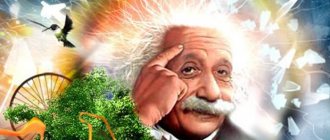Scientific research continues. The level of education of the population is growing. Surrounded by technological marvels, from wearables to communications satellites, we have to be damn smart and understand the science, right? The problem is that we (okay, not us, but many) are terrible ignoramuses when it comes to fundamental scientific knowledge. Only 53% of people know that the Earth revolves around the Sun every year, and only 59% of people know that the first people and dinosaurs lived at different times, not like in The Flintstones. Only 47% of people accurately answer that 70% of the Earth's surface is covered with water.
Clearly, although we have come a long way, there are still many steps ahead before we achieve universal scientific literacy. But for those of you who are desperate to change the subject when someone mentions the Higgs boson, supercomputers, or starts arguing about dinosaurs having feathers, there's a good reason to read this article. This article is about ten scientific questions that everyone should know the answers to.
Super difficult erudition test
It consists of 50 questions and answer options. Pictures and correct answers are displayed here. Testing takes place with the submission of correct answers immediately.
Here you will come across different topics and facts that you need to know. There are easy questions, but it can be difficult to select answer options based on historical data, such as the year Kennedy was assassinated or where Mombasa is located. Well, go ahead for new knowledge or reproduction of old ones! I have never seen a larger test than this and another one, which is described below.
Take the test →
What is the age of the Earth?
Probably not a single New Year on our planet goes by without someone seriously saying: “I can’t believe that the Earth is turning 2015!”
Or 2021, or 2017... The real age of the Earth has long been the subject of fierce debate. As early as 1654, a scientist named John Lightfoot, whose calculations were based on the biblical Book of Genesis, proclaimed that the Earth was created at 9 a.m. Mesopotamian time on October 26 in 4004 BC. e. In the late 1700s, the scientist Comte de Buffon heated a small replica of the planet he created and measured the rate at which it cooled, and based on this data he estimated the age of the Earth at 75,000 years. In the 19th century, physicist Lord Kelvin estimated the age of the Earth at 20-40 million years. But all this went to waste with the discovery of radioactivity. Subsequent calculations showed the rate at which various radioactive substances decay. Earth scientists have used this knowledge to determine the age of Earth's rocks, as well as samples from meteorites and rocks brought back from the Moon by astronauts. They looked at the decay state of the lead isotopes from the rocks and then compared them to a scale that showed how the lead isotopes changed over time. The Earth was formed approximately 4.54 billion years ago, with an error of less than one percent.
The most accurate erudition test in 2020
This is a new questionnaire consisting of 50 multiple-choice questions. It contains information from the school curriculum, knowledge of the environment and life experience. Since it is long, it was divided into 3 parts.
The first part consists of questions about cooking, religion and basic facts. The second part includes information about literature, creativity, computer science, and physics. The third part summarizes all the topics and tests your ability to concentrate. There are no very difficult questions here, but they are all designed for attention to detail and basic knowledge.
Take the test →
Will the Sun ever go out?
If you think that the Sun stops shining for a person when he is going through difficult periods of his life, then in reality it is not so.
The irony is that the reality around us - the light of the Sun, the singing of birds - is more durable than our fragile feelings. Unless you were born 5.5 billion years later. At this point, the Sun, like another star, like a giant thermonuclear reactor, will exhaust all the hydrogen in its core and begin to burn hydrogen in the surrounding layers. This will be the beginning of the end of the Sun - the core will shrink and the outer layers will expand, and the star will become a red giant. In a final flare, the Sun will fry the Solar System with a blast of heat that will turn even the cool environs of Pluto and the Kuiper Belt into a celestial sauna. The inner planets, including the Earth, will be sucked into the dying giant or turn to ash.
However, if people do not colonize the solar system or other stars, no one will know about this final hell. The sun, which is already halfway through its lifespan, is gradually warming up, and after a billion years it will be 10% larger. The increase in solar radiation will be enough to evaporate all of the earth's oceans, leaving us without water and other pleasures of life.
Test for children from 8 to 12 years old: testing a child’s erudition is simple and easy
Here are 15 questions that are designed for the logic, knowledge and experience of the child.
The test is great for motivating children to learn more. It is made in the form of a quiz so that the student would be interested in answering and seeing his level of development in the results.
Take the test →
Friends, if you want to find out much more about yourself, I advise you to take another test.
The Cognitive Abilities Test from Vikium is a diagnostic program for assessing the functioning of cognitive functions (attention, memory, thinking) and compiling a psychological profile of an individual.
What you will get as a result of the test:
- Personal profile card with assessments of cognitive abilities and personality characteristics.
- You will learn your strengths and weaknesses in various cognitive areas, as well as personality traits.
- You will understand what is associated with your productivity in certain types of activities and what needs to be done to improve it.
Testing includes complex diagnostics (cognitive profile):
- concentration and switching of attention;
- verbal and non-verbal logic;
- visual-figurative thinking;
- verbal-logical memory;
- short-term and long-term memory.
You will determine (personal profile):
- type of thinking and level of creativity;
- leading style of activity;
- ability for self-regulation;
- personality type with all its features.
Suitable for a wide range of users: teenagers over 14 years old, adults and the elderly.
You don’t need any special knowledge to pass; the test takes place in a playful and test form.
Duration: 30–40 min.
Cost: 990 rub.
Who Vikium is and why they are great, you can read in our special review.
How does natural selection work?
Like the age of the Earth, the theory of evolution—first developed by biologist Charles Darwin in the mid-1800s—is a topic that people don't know but love to discuss.
Nowadays, opponents of the theory of evolution are trying to remove it from the curriculum in schools or to have children study “the science of creation” in addition to the theory of evolution. And there is one idea that opponents of evolution cling to: natural selection, Darwin's central concept. This idea is quite simple to understand. In nature, mutations—that is, a permanent change in the genetic program of microorganisms that will subsequently distinguish a species from its predecessor—occur randomly. But evolution, a long process in which animals and plants undergo many changes over many generations, is not accidental. Typically, changes in organisms become more common over time if they help the organism survive and reproduce.
For example, imagine that some beetles are green, but due to mutation they turn brown. Brown beetles blend in better with their surroundings than green beetles, so they are not often eaten by birds. More of them survive, they reproduce in greater numbers, and these changes become not temporary, but permanent. Over time, the beetle population will turn brown. But this is the simplest option. In practice, natural selection takes statistical averages as a basis, rather than specific representatives, and it is not very easy to isolate this process.
What causes a rainbow?
There is something special about this atmospheric phenomenon that has aroused awe in people since ancient times.
According to the Book of Genesis, the Lord placed a rainbow in the sky after the Great Flood and told Noah that it was “a sign of the agreement between Me and the earth.” The ancient Greeks went further and decided that the rainbow was the goddess Iris. True, her figure was ominous - she heralded war and retribution. Over the centuries, great minds, from Aristotle to Descartes, have tried to figure out what process produces the colors of the rainbow. Now, of course, scientists know this well. Rainbows are caused by water droplets that remain suspended in the atmosphere after a good rainfall. The density of the droplets is different from the density of the surrounding air, so when sunlight hits them, they act as tiny prisms, breaking the light into its component wavelengths and then reflecting them back. An arc is born with stripes of the color of the visible spectrum that we see. Because the drops are supposed to reflect light towards us, to see a rainbow you need to have your back to the sun. You also need to look from the ground at an angle of about 40 degrees - this is the angle of deflection of the rainbow, that is, the angle at which it refracts sunlight. It is also interesting that, while on an airplane, you can see a rainbow in the form of a disk, rather than an arc.
Society and world
In the United States, the status of an official language is uncertain.
At the federal level, the country does not have an official language. In most states, English is recognized as the official language at the local level. But in some states, Spanish, French and Hawaiian have official status.
George Washington was not the first president of the United States, but the fifteenth.
Simple math will help here. The US Declaration of Independence was adopted in 1776. While the head of the independent States, George Washington became 30 in 1789. Who, in this case, ruled the country for these 13 years? The answer is simple: other presidents. That is why many historians consider Peyton Randolph to be the first president.
Only Randolph's position was called differently - head of the First and Second Continental Congress. And George Washington became the one who first tried on the title of “president”.
Mendeleev did not invent vodka.
The famous Russian chemist in 1865 actually wrote a dissertation “Discourse on the combination of alcohol with water,” but this has nothing to do with the invention of vodka. In his scientific work, the chemist discussed changes in the properties of aqueous solutions of alcohol at different concentrations and conditions. He did not place any emphasis on the 40% alcohol ratio. In addition, the strong drink was known long before the birth of Mendeleev. And the word “vodka” itself was first mentioned in Poland in 1405. Back then, however, the drink was more often called gorzałka (gorzeć - “to burn”), hence the origin of the Ukrainian name - “gorilka” - and the Belarusian one - “garelka”. And in 1819, Russian Tsar Alexander I signed the “Regulations on Vodkas,” which actually discussed the requirements for the production of the strong drink.
The first light bulb was made in the Russian Empire.
The light bulb does not have a single inventor. And although the invention is closely intertwined with the name of the American physicist Thomas Edison, the history of the light bulb represents a whole chain of discoveries made by different people at different times. And the first was the Russian scientist Alexander Lodygin. He also proposed using tungsten filaments in lamps and twisting the incandescent filament in the shape of a spiral that is already familiar to us. He was the first to propose pumping air out of light bulbs, thereby extending their service life many times over.
Edison simply turned out to be the best marketer and visionary. He patented his invention in the USA in time, and later bought the patent from Lodygin.
The outcome of gladiator fights was not decided by the position of the thumb.
Moreover, the like that is familiar to many, according to some historians, was interpreted as….execution! And all because the thumb thrown in any direction symbolized a drawn sword. While a tightly clenched fist, on the contrary, meant pardon. But in fact, the scale of the Colosseum did not allow the gladiators to see the gestures on the podium. Therefore, over time, the fate of a defeated fighter was decided by raising a handkerchief of a certain color - white or red.
Antique statues were colorful.
When you mention ancient statues, smooth marble sculptures with clear depictions of muscles, emotions and drama come to mind. It was this aesthetics that later inspired the great sculptors of the Renaissance. Only the original statues from Ancient Greece and Rome were brightly painted, which added some comedy to them and detracted from their monumentality.
How do magnets work?
For a long time, magnets were considered something of a miracle.
And this is sad, because understanding the principle of their operation is quite simple. A magnet is any object or material that has a magnetic field. That is, a bunch of electrons in it float in one direction. Electrons love to form pairs, and in iron, for example, there are many unpaired electrons that are easy to tie up to some party. Therefore, objects made of solid iron or generally with a large amount of iron will be attracted to a sufficiently powerful magnet. Substances and objects that are attracted to magnets are called ferromagnets. People have known about magnetism since time immemorial. Magnets are found in nature, and medieval travelers learned to magnetize steel compass needles, that is, they created their own magnetic fields. Such magnets were not particularly strong, but in the 20th century, scientists developed new materials and chargers that led to the creation of powerful permanent magnets. You can create an electromagnet from a piece of iron by wrapping it in electrical wire and connecting the ends to the poles of a large battery.
What is the theory of relativity?
When someone mentions “the theory of relativity,” they are usually referring to two theories, special and general, developed by physicist Albert Einstein in the early 1900s.
Regardless of the degree of our reverence for Einstein, people far from science have little understanding of his theories. Einstein himself came up with a good way of explaining: “When a man sits with a pretty girl for an hour, it seems to him that a minute has passed. But let him sit on a hot stove for a minute, and it will seem longer than an hour to him. Everything is relative". Everything seems to be clear, although the details, of course, are more complicated. Before Einstein, everyone largely believed that space and time were stationary and monotonous, never changing, no matter where you looked at them on Earth. But Einstein used mathematics to prove that the absolute view of things is an illusion. In fact, space and time change: space can contract, expand, bend, and time flows at different speeds depending on the speed of the object or the strength of the gravitational field.
In addition, the manifestation of space and time may depend on the person's point of view. Imagine, for example, that you are looking at an old ticking clock. Now place this clock in Earth's orbit so that it moves at a tremendous speed compared to your position on Earth. The clock in orbit will tick slower.
Clocks run slower due to the phenomenon of “time dilation.” Space and time are actually parts of one whole space-time, which can be distorted by gravity and acceleration. Therefore, if an object is moving very fast or is subject to a very strong gravitational field, time will pass slower for that object compared to an object that is not subject to the same influence. Using mathematical calculations, you can predict how time will slow down for fast moving objects.
This probably sounds strange. But it's true. GPS satellites, which depend on precise time measurement to map the Earth, are a good example of this. The satellites fly around the planet at a speed of about 14,000 kilometers per hour, and if engineers had not adjusted the clocks to take into account relativity, then within a day Google maps would be off by almost 10 kilometers during positioning.
Why are bubbles round?
Yes, bubbles are not always perfectly round, as you must have noticed if you've ever blown them.
But the bubbles tend to be spherical, and you can see that even the longest ones tend to become round. The fact is that bubbles are essentially thin layers of liquid, the molecules of which are held together by a phenomenon called cohesion. This creates surface tension, a barrier that prevents objects from penetrating through it. But this is not the only force that acts on this layer. Air molecules press outside. The most effective way for a liquid layer to counteract these forces is to adopt its most compact shape, which is a sphere when calculated by its volume-to-area ratio. What is noteworthy is that scientists have long learned to make non-circular bubbles - cubic, rectangular (by stretching a thin layer of liquid on a wire frame), whatever.
Why does water evaporate at room temperature?
We humans tend to think of reality as a nice, stable place where things stay in place unless we want to move them.
But the reality is different. If you look at water at a molecular level, the molecules look like a pack of puppies fighting for the best position on their mother's belly. When there is a lot of water vapor in the air, the molecules bump into the surface and stick to it, causing condensation to form on the outside of a cold drink on a humid day. Conversely, when the air is dry, the water molecules in your cup can stick to other molecules floating in the air. This process is called evaporation. If the air is dry enough, more molecules will move from the cup to the air than fall out of the air into the cup. Over time, the water will lose more molecules and you will eventually end up with an empty cup.
The ability of liquid molecules to jump into the air and stick to it is called vapor pressure because the jumping molecules exert a force, just like a gas or solid pushing down on something. Different liquids have different vapor pressures. For acetone, for example, this indicator is high, that is, it evaporates easily. Olive oil, on the other hand, has a low vapor pressure and is unlikely to evaporate at room temperature.
Survival Skill
We live in such a calm time that the ability to independently light a fire, navigate by the stars and find water may seem like a monstrous anachronism. However, these and other survival skills may very well come in handy one day. And it doesn’t have to be somewhere on a hiking trip or trip. Non-standard situations happen to people quite often, and sometimes completely unpredictably. You can get lost while walking, your car can stall on a winter night road, and no one is immune from natural disasters. It is always better to be prepared in advance for emergency situations than to helplessly throw up your hands later.
What are clouds made of?
We hope we don't disappoint anyone, but clouds are not actually a mixture of ice cream and angel feathers.
Clouds are a visible mass of water droplets or ice crystals, or a mixture of both, that are suspended above the surface of the Earth. Clouds form when moist, warm air rises. As it rises higher and reaches cold areas, the warm air cools and the water vapor condenses into tiny water droplets or ice crystals, depending on the temperature. These drops and crystals stay together thanks to the principle of cohesion, which we talked about just above. This is how a cloud is born. Some clouds are thicker than others because they have a higher density of water droplets. Clouds are a key part of our planet's hydrological cycle, during which water constantly moves between the surface and the atmosphere, alternating between liquid, solid and gaseous states. If not for this cycle, life on our planet might not exist.
In 1803, meteorologist Luke Howard identified four main classifications of clouds, which today have Russian and Latin names. Cumulus, or cumulus clouds, are the piled-up lumpy clouds that we often see in the sky. Cirrus, cirrus clouds, which means "hair" in Latin, are light feathers at altitude, fine as strands of hair. Flat and nondescript clouds are stratus, which means “layer” in Latin. There are also nimbus clouds, low and gray rain clouds. However, there are slightly more subspecies and varieties of clouds, as well as their mixtures.
Words you need to know. 20 words you need to know to look smart in conversation
20 words you need to know to look smart in a conversation 1. Sentence - moralizing. 2. Equivocations - ambiguous hints, subterfuges. 3. Deviant – a person who does not conform to the norm. 4. Catharsis - a change in consciousness through strong experiences. 5. Ataraxia – peace of mind, equanimity, serenity, wisdom. 6. Deprivation – a feeling of insufficient satisfaction of one’s needs. 7. Amok - a sudden violent mental disorder 8. Frustration - a period of complete disappointment in life. 9. Palinphrasy – pathologically frequent repetition of certain words or phrases in speech (for example, “damn”, “as if”, “actually”). 10. Antimony - chatter, empty talk (create antimonies). 11. Haptophobia – fear of being touched by other people. 12. Mojo - originally an African magical amulet (amulet) for happiness and good luck; in modern cultures the word has come to mean a positive state, something like charming charisma, which, by the way, can be lost. 13. Fetish is an object of blind, unconscious worship. 14. Distinia – depressed, melancholy mood. 15. Gestalt is a form or image, as some kind of holistic formation and the fundamental basis of the psyche. 16. A freak is a person distinguished by a bright, unusual, extravagant appearance and defiant behavior, as well as an extraordinary worldview, which is the result of a rejection of social stereotypes. 17. Zugzwang is a forced move in a chess game that worsens the position of the player who made it. In a broad sense: a situation in which any actions only worsen the situation. 18. Frisson - goosebumps. 19. A texttrovert is someone who finds it easier to talk about their feelings via SMS than in person. 20. Glossophobia – fear of speaking in public.
Golden rules of psychology for happiness
The psychology of human life is very multifaceted, including the psychology of success, development, communication, and personal growth. What is needed first of all for a happy life? Let's consider the basic rules of psychology for a happy person:
Our life is our thought, a reflection of aspirations
A person cannot change the circumstances of life, but he can change his attitude, opinion, and thoughts. A person’s life moves in the direction of the most powerful thoughts, concentration of attention, it is useful to learn to direct thinking in the direction of success, prosperity, happiness. By thinking positively, we create a new world, and by planning new achievements, we create the foundation for a new life and future success.
Unusual Facts About Sleep
Sleep is an extraordinary human state. People spend 1/3 of their lives sleeping . This is the time when the brain processes and decides what to forget and what to remember from the learned information of the day.
Get a good night's sleep before any major task.
Before the exam, after you have memorized the tickets and before memorizing them, quickly go to bed. According to psychologists, a person’s character can be judged by how he sleeps. People who sleep in a curl are isolated from the outside world. The longest dream was recorded by D. Powell in 1994 - its duration was 3 hours 8 minutes, the man was examined in the American city of Seattle. The essence of prophetic dreams is also extremely interesting. Scientists have long found out that the cerebral cortex becomes less active when a person falls asleep. While he does not know about his illness, this news already exists in the affected blood cells. It is reproduced in the form of dreams and images. According to doctors, flu and colds can be predicted 1 or 2 days before symptoms appear, and ulcers 2 to 3 weeks before. During research on dreams, British professionals found that for a positive mood, people should sleep 7 hours a day .
The table of chemical elements that Mendeleev dreamed about is one of the most famous dream phenomena in science.
Professionals believe that this comes true when a person persistently solves a problem.










